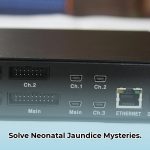Jaundice in newborns, if undetected, can lead to serious complications. This guide offers step-by-step instructions for accurate bilirubin measurement using a transcutaneous bilirubin (TcB) meter, covering equipment, technique, interpretation, and troubleshooting for optimal newborn care. For a comprehensive neonatal jaundice screening protocol, see this helpful guide.
Training for Neonatal TcB Screening: Preventing Kernicterus Through Accurate Measurement
Jaundice, characterized by a yellowish discoloration of the skin and eyes, is a common condition in newborns resulting from elevated bilirubin levels. While often benign, significant hyperbilirubinemia requires careful monitoring using transcutaneous bilirubin (TcB) screening. TcB provides a non-invasive method to estimate bilirubin levels and prevent kernicterus, a rare but devastating form of brain damage. This guide offers a comprehensive overview of neonatal TcB screening, designed for healthcare providers involved in newborn care.
Understanding Jaundice and TcB Screening for Early Detection
Bilirubin, a yellow pigment produced during the normal breakdown of red blood cells, can accumulate in newborns if their livers are not yet fully able to process it. Early detection of hyperbilirubinemia is crucial to prevent potential neurological damage. TcB screening offers a rapid, non-invasive method to estimate bilirubin levels. A TcB meter measures the light reflected from the skin to estimate the concentration of bilirubin. It’s essential to understand that TcB provides an estimate and does not replace a blood test (total serum bilirubin or TSB) when precise measurements are required.
Preparation: Equipment and Calibration of the TcB Meter
Treat your TcB meter as a critical diagnostic instrument. Before each screening session, ensure it is properly calibrated according to the manufacturer’s instructions using the provided calibration standard. Improper calibration is a frequent cause of inaccurate readings. Always use disposable probe covers to maintain hygiene and prevent cross-contamination. Strict adherence to the manufacturer’s recommended procedures guarantees optimal performance and reliable results.
Step-by-Step TcB Measurement: A Method for Newborns
The following represents a systematic approach to performing TcB measurements on newborns:
- Preparation: Gather all necessary equipment, including a calibrated TcB meter and a supply of new, individually wrapped probe covers. Perform hand hygiene meticulously and ensure a clean, dry testing environment.
- Infant Preparation: Gently position the baby for testing. Select a skin area that is clean, dry, and free from any visible bruises, birthmarks, or rashes. The sternum (breastbone) or upper abdomen are typically recommended sites.
- Probe Placement: Apply a fresh, unused probe cover to the meter’s probe tip. Gently but firmly place the probe against the prepared skin, ensuring consistent and complete contact throughout the measurement process. Avoid applying excessive pressure.
- Reading Acquisition: Most TcB meters provide a digital reading within a few seconds. Some models may require multiple readings to improve accuracy; follow the meter’s specific instructions carefully.
- Result Recording: Meticulously record the obtained TcB value, along with the date, time of measurement, and pertinent infant details such as weight, gestational age at birth, current feeding method (breast milk or formula), and any relevant clinical observations.
Inconsistent technique when performing the measurement steps described above can lead to unreliable readings. Regular practice and adherence to established protocols will increase both your accuracy and confidence.
Interpreting TcB Readings: Context is Key
A TcB reading is just one piece of the clinical picture. Accurate interpretation requires considering several key factors:
- Gestational Age: Premature infants process bilirubin differently than full-term infants and may require lower intervention thresholds.
- Birth Weight: Low birth weight infants are at increased risk for hyperbilirubinemia.
- Age in Hours: Bilirubin levels normally rise in the first few days of life before declining. Interpret TcB values in the context of the infant’s age in hours using established hour-specific bilirubin nomograms.
- Feeding Type: Breastfed infants may exhibit higher bilirubin levels in the first few days compared to formula-fed infants.
- Risk Factors: The presence of risk factors such as bruising, cephalhematoma, sibling history of jaundice, or isoimmune hemolytic disease increases the risk of significant hyperbilirubinemia.
Remember that TcB is an estimate, and its accuracy tends to decrease at higher bilirubin levels. A total serum bilirubin (TSB) measurement should be obtained whenever the TcB value approaches established treatment thresholds or when clinical concerns persist. Clinical judgment, informed by these factors, is paramount; TcB is a valuable screening tool but not a definitive diagnostic test.
Decision-Making: Algorithms for Newborn Care
Use the TcB reading, alongside clinical factors and professional judgment, to determine the appropriate course of action:
- Obtaining a TSB: Order a blood test for a precise measurement of bilirubin level to confirm the TcB.
- Initiating Phototherapy: Start treatment with special lights to help break down excess bilirubin if levels are too high.
- Consulting a Specialist: Seek expert advice from a neonatologist if needed.
Clear guidelines and algorithms improve consistency in care. Timely intervention is essential to prevent complications.
Troubleshooting: Identifying and Correcting Problems
Inaccurate readings can arise from various factors, including improper calibration, inadequate contact between the probe and the skin, or skin conditions that interfere with light transmission. Regular calibration checks and meticulous technique are crucial for minimizing errors. If an unexpected or questionable TcB value is obtained, repeat the measurement, ensuring proper technique, and consider obtaining a confirmatory TSB.
Maintaining Accuracy: Quality Assurance and Control
Regular quality control checks are crucial for maintaining the accuracy and reliability of your TcB meter. Routine maintenance ensures consistent performance over time. Quality control measures should include regular calibration verification using a standardized calibration device, periodic equipment maintenance according to the manufacturer’s recommendations, and ongoing competency assessment and training for all staff members who perform TcB measurements.
Staying Updated: Continuous Learning
Neonatal jaundice management evolves with ongoing research. Stay up-to-date with the latest guidelines from organizations like the American Academy of Pediatrics (AAP) and relevant research to provide your patients with the best possible care.
Conclusion: Improving Neonatal Jaundice Screening
Mastering neonatal TcB screening empowers healthcare providers to detect and manage neonatal jaundice effectively, improving outcomes for babies. By adhering to established guidelines, employing meticulous technique, and engaging in continuous learning, you can refine your skills and contribute to ensuring a healthy start for every newborn in your care.
Universal vs. Risk-Based Neonatal Jaundice Screening
Effective jaundice detection is essential for preventing kernicterus. The decision between universal and risk-based screening is crucial. Both strategies have their advantages; you must consider several factors to determine the optimal approach.
Understanding Screening Choices
The core decision is whether to screen all newborns (universal screening) or to target screening efforts toward those identified as being at higher risk (risk-based screening). Universal screening aims to detect all cases of hyperbilirubinemia but may lead to unnecessary testing and increased parental anxiety. Risk-based screening is a more targeted and potentially cost-effective approach but carries the risk of missing significant hyperbilirubinemia in infants not initially identified as high-risk.
Key Factors to Consider
Several critical factors must be considered when deciding between universal and risk-based neonatal jaundice screening, specifically resource availability, population demographics, cost-effectiveness, and potential clinical outcomes.
- Resource Availability: Assess the available resources for widespread screening. Universal screening requires significantly more resources than a risk-based approach. This includes staffing, equipment (TcB meters), and laboratory capacity for follow-up TSB measurements.
- Population Demographics: Consider the specific population being served. The prevalence of jaundice and risk factors for hyperbilirubinemia can vary significantly across different populations. Higher-risk populations may benefit more from a universal screening strategy.
- Cost-Effectiveness: Evaluate the cost per identified case of significant hyperbilirubinemia and weigh it against the potential benefits of early detection and intervention. Universal screening is generally more expensive overall, while risk-based methods may be more affordable but could miss critical cases.
- Clinical Outcomes: The primary goal is to prevent severe hyperbilirubinemia and its neurological sequelae. Consider the long-term impact of each screening strategy on clinical outcomes, including rates of phototherapy use, exchange transfusions, and bilirubin encephalopathy.
- Training & Expertise: Accurate screening requires well-trained healthcare providers. The effectiveness of both screening methods depends on the competency of the staff performing the measurements and interpreting the results. Invest in high-quality training to ensure accurate and reliable screening, regardless of the chosen approach.
Step-by-Step Guide to TcB Screening (Regardless of Screening Type)
Regardless of the chosen screening strategy, accurate TcB measurements are critical. Here’s a standardized step-by-step guide to minimize errors:
- Prepare the Infant: Ensure the infant’s skin is clean and dry. Avoid areas with bruising, edema, or excessive hair.
- Calibrate the TcB Meter: Perform calibration of the TcB meter according to the manufacturer’s instructions before each use or screening session.
- Sensor Placement: Gently position the TcB sensor on the infant’s skin. The forehead or upper sternum are commonly used sites, but follow the device manufacturer’s recommendations for optimal placement.
- Obtain Reading: Follow the device-specific instructions to obtain a stable and valid TcB reading. Multiple readings may be necessary to ensure
- Water Wheel Electric Generator Provides Free Home Electricity - December 15, 2025
- Choosing the Right Portable Hydro Turbine for Your Needs - December 14, 2025
- Best Portable Hydro Generators for Off-Grid and Outdoor Power - December 13, 2025
















